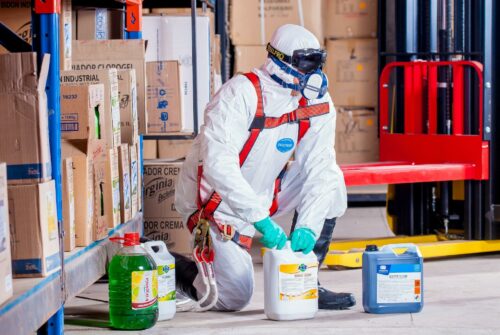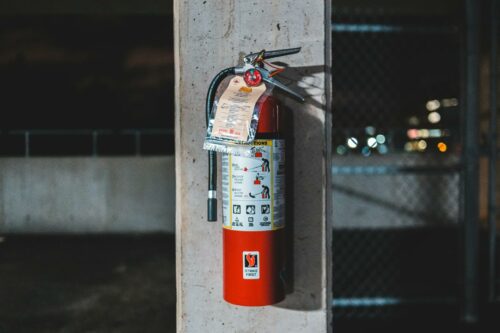Free Quick Workplace Safety Checklist
Oct 2022
Workplace safety isn’t just good practice, it’s a legal requirement. This blog has all the info you need to stay on the right side of safety and the law.
Safety regulations apply to businesses of all sizes - even if you have fewer than five employees. Startups should take health and safety seriously from the outset, even if they’re a fully remote team of just a few people!
Complying with health and safety is simple for most businesses and startups, and the law understands that most risks are proportionate to the business.
Health and safety: key legislation
Business owners and startup founders should take health and safety seriously from day one. Most small companies should have no issues with health and safety, but planning accordingly helps protect employee wellbeing while satisfying - or preferably exceeding - compliance.
There are four main laws addressing health, safety, and wellbeing in the workplace:
Three other more specific pieces of legislation include:

Some business activities fall under stricter health and safety rules
The main law - HSWA - is needed when establishing employer responsibility, whereas the Management of Health and Safety at Work Regulations 1999 sets practical rules for risk assessments and management.
It’s important to note that rules apply to both on premises sites and workers and remote or home workers. Employers have a responsibility to all employees, no matter where they are. Don’t get caught out in assuming health and safety law doesn’t apply just because you run a remote team.
Workplace safety revolves around identifying risks and creating a policy to address them.
Want to become a more effective director?
Do you need a written policy?
All businesses need to carry out risk assessments, but not all must produce written policies. Businesses with five or more employees must create a written policy with three clearly labelled sections:
The statement of intent
Section of responsibilities for health and safety
Section on how health and safety will be arranged and managed
Part of this involves appointing a ‘competent person’ who’ll help with health and safety.
For most small businesses, the competent person doesn’t need any level of training or qualification and could be the business owner or an employee. But, larger or high risk businesses will likely need designated health and safety officers to actively manage policy on a daily basis.
Workplace risks to be aware of
There are lots of key risks that you need to be aware of. Including:
Manual handling: Workers need to be informed how to safely lift, pull, push, carry or handle bulky and heavy items. Manual handling management is critical to preventing workplace injuries.
Display equipment: Computers and other display screen equipment (DSE) can inflict sprains, strains, and RSI. Employers must help employees manage such risks and provide adjustable seats and workstations if necessary. This also applies to home workers.
Fire safety: The Regulatory Reform (Fire Safety) Order 2005 makes fire safety risk management mandatory for all business premises. Premises must be equipped with smoke alarms, fire blankets, and extinguishers. Additional rules apply to hot machinery and flammable materials.
and safety rules and regulations today. This applies to all workers, including home workers.
There are many other workplace risks for specific industries, especially those that involve manufacturing, physical processes, etc. View HSE’s A-Z of guidance by industry here.
All businesses should take health and safety seriously. If you’re a startup looking for more advice, join 5,000 other founders in Accountancy Cloud’s School of Startups.

Writing a health and safety policy
Businesses with more than five employees need to write their health and safety policies down.
Hazards should be documented and written down to reduce harm. Provisions should be managed and delivered, e.g. with first aid kits and fire safety gear. These should be labelled appropriately, and you should inform employees of where they are and how to use them.
The minimum risk assessment the Health and Safety Work Regulation require include:
Identifying situations, equipment, and events that might potentially cause injury or illness - these should be labelled as “the hazards.”
Evaluating the chances that employees can be harmed and how serious harm might be - these should be labelled as “the risks.”
Management and control strategies to reduce, control, and eliminate hazards and their risks.
You should check storage shelves, trip and slip hazards, swinging doors, flooding risks, equipment protocols, and loose wires.
If you have a higher risk business, you may need a health and safety officer to check and document risks. Serious accidents need to be reported to HSE’s RIDDOR (Reporting of Injuries, Diseases and Dangerous Occurrences Regulations).
Writing a health and safety policy
A health and safety policy should include the following:
1: Statement of intent
The statement of intent summarises the policy and indicates how the business intends to tackle its obligations. It should be signed off by the most senior person in the business. For many startups, this will be the owner or founder.
2: Responsibilities for health and safety
Employees must be delegated roles for health and safety, such as administering first aid, utilising fire safety equipment, etc. In some cases, the business should create an organisation chart. However, higher management has ultimate responsibility for health and safety policy.
3: Arrangements for health and safety
This is by far the most comprehensive section. It includes all information for managing risks and arrangements for delivering protection, whether through periodical assessments, questionnaires, meetings, etc.
Evacuation plans and emergency provisions will be included here.
Fire safety assessments
Fire safety is one of the most important components of a workplace risk assessment.
The Regulatory Fire Safety Order 2005 (RRFSO 2005) provides a framework for regulating fire safety in commercial workplaces. It’s a long piece of legislation, and rules are much more stringent for larger premises with complex fire safety requirements.
Even so, fire assessments apply to all businesses with physical premises, including small businesses. As a result, they’re a crucial consideration for startups considering their own office space.
Key fire safety factors include:
Emergency procedures and training
Drawing up fire risk assessments to identify potential hazards and risks
Fire safety systems and equipment
Escape routes

Here’s your workplace fire checklist:
1: Fire detection and smoke alarms
Are fire alarm systems maintained properly?
Are systems regularly tested to ensure they work as expected?
Are there enough alarms?
Is there a procedure for contacting emergency services?
Are the fire detection and alarm systems appropriate for the premises?
2: Fire safety equipment
Are evacuation plans clearly visible to all employees and visitors?
Are fire doors kept closed at all times and free from any obstructions?
Is fire safety equipment training sufficient?
Are fire extinguishers installed in relevant areas throughout the premises?
Some premises need emergency lighting with a generator separate from the mains power in the case of a power failure.
3: Fire drills
Are all escape doors clearly marked and left clear at all times?
Are all staff aware of evacuation plans and drills, and are they informed on the correct evacuation route?
Do you conduct regular fire drills?
Do you have a register to identify all staff and visitors once they’ve safely exited the building?
Are sockets not overloaded?
Have all combustible materials or flammable liquids been separated from electrical appliances?
Does the electrical system show signs of faults, damage or wear and tear?
5: Storage
Are combustible materials (paper, wood, etc.) stored appropriately far away from fire risks?
Other rules apply to flammable liquids.
6: Kitchen
Is cooking and heating equipment well-maintained?
Is the kitchen workplace equipped with proper ventilation? Are they maintained?
Is there a dry chemical fire extinguisher installed in the kitchen area?
Rules apply to kitchen appliances in offices and other rooms
7: People
Personal Emergency Evacuation Plans (PEEPS) need to assess individual needs, focusing on vulnerable individuals.
Have you informed all staff of fire safety protocol and procedures and where the fire assembly point is located outside?
Have you provided fire safety training to nominated responsible employees?
Do responsible individuals know how to evacuate the building safely and handle any relevant fire safety equipment?
Summary
Workplace health and safety assessments are mandatory in the UK. If you have more than five or more employees, you’ll need a written policy that addresses workplace hazards, risks, and responses. You’ll also need to dedicate a competent individual to take care of certain health and safety duties, such as administering first aid.
The bigger a business is, the more rules apply. Large or high risk businesses will need to appoint health and safety officers to draw up policies, monitor risks and make sure appropriate training is in place.
Even remote businesses need to take health and safety seriously. So if you’re a startup looking for the latest and greatest guides, podcasts, advice and more, then join 5,000 other founders in Accountancy Cloud’s School of Startups.
#1 finance partner for tech & e-commerce startups
- 100% online
- All in one accountancy, R&D and CFO services
- 9/10 customers recommend us

Educational content just for startups. As a member, you’ll get unlimited access to an extensive range of guides, blogs and advice to help you run and grow your business.


